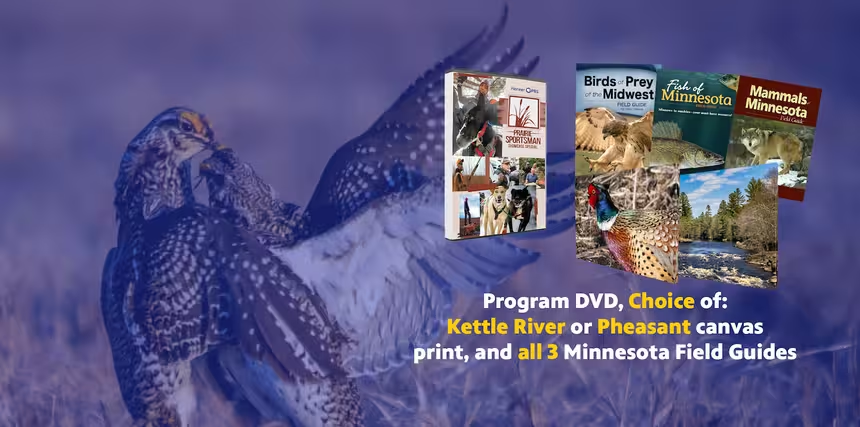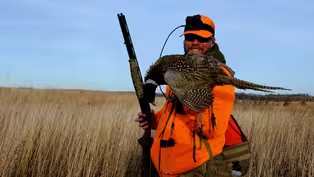Prairie Sportsman
Building More Birds
Clip: Season 16 Episode 13 | 13m 55sVideo has Closed Captions
Bret shares the wonderful world of wildlife in a food plot built for pheasants.
Host Bret Amundson brings his camera to a food plot built for pheasants and provides a window into the wonderful world of wildlife that benefit from it. From deer and bunnies to ducks and geese. See pheasants by the dozens going about their daily lives.
Problems playing video? | Closed Captioning Feedback
Problems playing video? | Closed Captioning Feedback
Prairie Sportsman is a local public television program presented by Pioneer PBS
Production sponsorship is provided by funding from the Environment and Natural Resources Trust Fund, West Central Initiative, Shalom Hill Farm, and members of Pioneer PBS.
Prairie Sportsman
Building More Birds
Clip: Season 16 Episode 13 | 13m 55sVideo has Closed Captions
Host Bret Amundson brings his camera to a food plot built for pheasants and provides a window into the wonderful world of wildlife that benefit from it. From deer and bunnies to ducks and geese. See pheasants by the dozens going about their daily lives.
Problems playing video? | Closed Captioning Feedback
How to Watch Prairie Sportsman
Prairie Sportsman is available to stream on pbs.org and the free PBS App, available on iPhone, Apple TV, Android TV, Android smartphones, Amazon Fire TV, Amazon Fire Tablet, Roku, Samsung Smart TV, and Vizio.

Prairie Sportsman Premium Gifts
Do you love the great outdoors, hunting, fishing, hiking and conservation? Consider becoming a friend of Prairie Sportsman to support it and receive gifts with your contribution.Providing Support for PBS.org
Learn Moreabout PBS online sponsorship- It is the age old question.
How do we get more game animals on the landscape, whether it be deer, ducks, upland birds?
Well, no matter the topic, the answer's always the same.
It's preserving and creating more habitat.
When it comes to creating habitat for wildlife, the key lies in the complex, a variety of grasses, thermal cover, food and water are all part of an ideal landscape for wild critters like deer, pheasants, ducks, and even small games such as rabbits.
A quality habitat complex will attract wildlife year round, but in the spring, as the males and females go through their annual breeding rituals, they'll be more visible before vegetation grows tall.
Here are a few of the things I've been fortunate enough to film in this well-managed complex.
Surviving the harsh Minnesota winters can be challenging for wildlife, but giving them thermal cover and shelter such as cattails and woody cover like this can make a big difference.
Shrubs and short trees offer protection from overhead predators, and evergreens can provide safety during winter storms.
It's recommended though to avoid planting other trees which can attract nest predators and give aerial hunters a perch to scout from.
Willow thickets and phragmite stands can offer suitable natural cover as well.
These willow thickets may be one of my favorite places to target late season for pheasant hunting and there's a reason why.
If you look right here, you can see we just had a big snowfall.
Big storm came through and the snow inside this thicket is just trampled.
Not just pheasants, but deer, rabbits, other small game have been using it as well too.
Wetlands in a complex can offer multiple benefits, including something as simple as giving wildlife a drink, but cattails may be the best all-around cover on the prairie.
If possible, a food plot situated close to thermal cover and large tracks of grasses can be the perfect complement to a habitat complex.
A mixture of foods such as corn, soybeans, brassicas, and sorghum benefit wildlife at different times of year with different conditions.
As snow piles up, food is covered.
Beans and corn that grow tall feed pheasants and deer during those long, cold, snowy months.
This complex has everything you need to help pheasants get through a tough winter with a lot of snow.
They'll use the willow thickets nearby, and at least twice a day, they will fly into the food plot using the tall corn as cover as they jump up to pick kernels along each row.
Having a variety of grasses and woody cover is important because after a big, wet, heavy snowfall like this one, a lot of this big blue stem can get knocked down and it's unusable.
But during the spring, this grass provides nesting cover for pheasants, other upland birds, and waterfowl like mallards and blue-winged teal, which have been known to nest up to a mile away from water sources in grass like this.
If you wanna build more birds or deer or other wildlife, consider creating a habitat complex on your property.
And there's plenty of organizations out there like Pheasants Forever, or even the Minnesota DNR that can help you get started.
Video has Closed Captions
Clip: S16 Ep13 | 11m 54s | Host Bret Amundson and Jason Markkula go on a pheasant hunt with sub gauge shotguns. (11m 54s)
Food Plots for Pheasants and Sub Gauge Hunt
Preview: S16 Ep13 | 30s | Sub gauges on a pheasant hunt and photographing unique visitors on a food plot planted for pheasants (30s)
Providing Support for PBS.org
Learn Moreabout PBS online sponsorship
- Science and Nature

Explore scientific discoveries on television's most acclaimed science documentary series.

- Science and Nature

Capturing the splendor of the natural world, from the African plains to the Antarctic ice.












Support for PBS provided by:
Prairie Sportsman is a local public television program presented by Pioneer PBS
Production sponsorship is provided by funding from the Environment and Natural Resources Trust Fund, West Central Initiative, Shalom Hill Farm, and members of Pioneer PBS.



